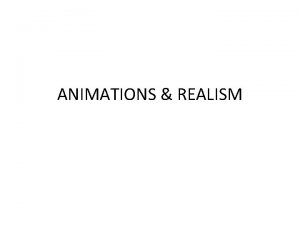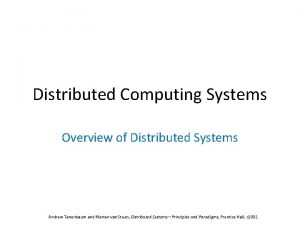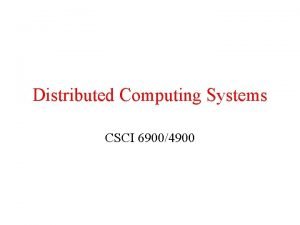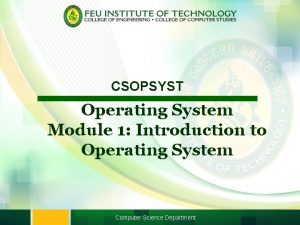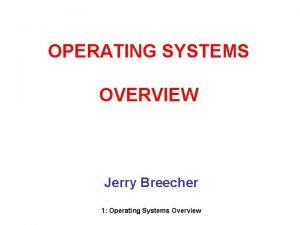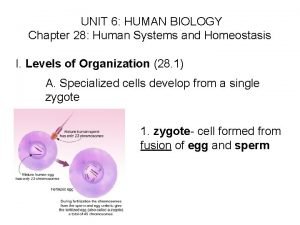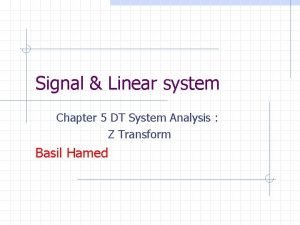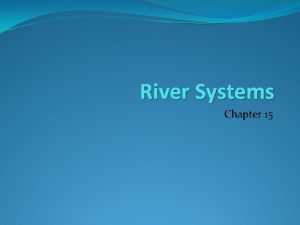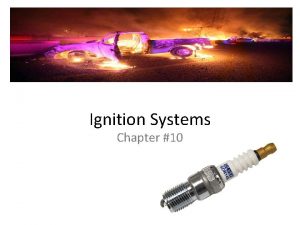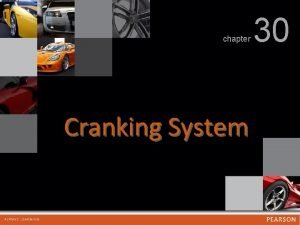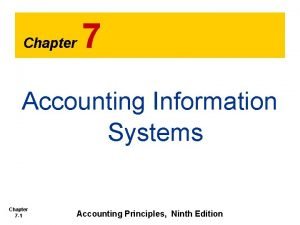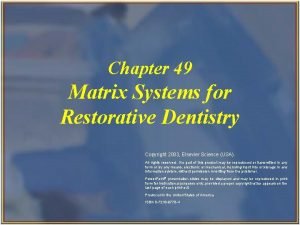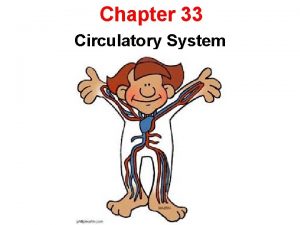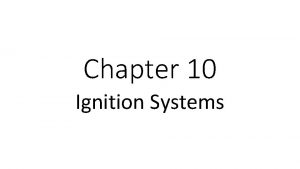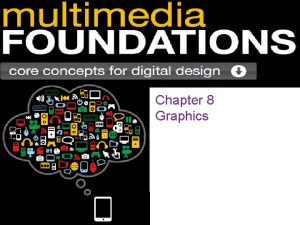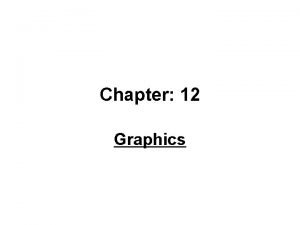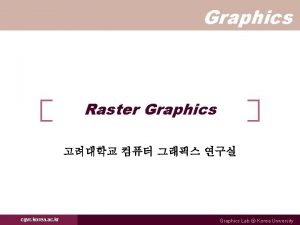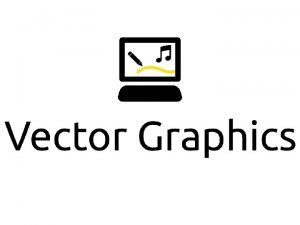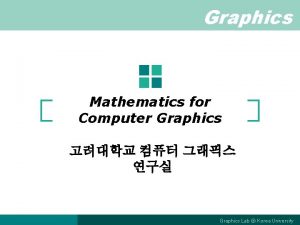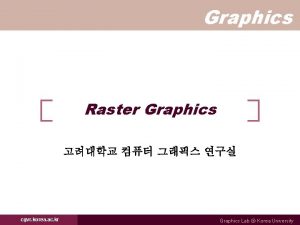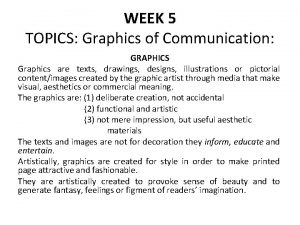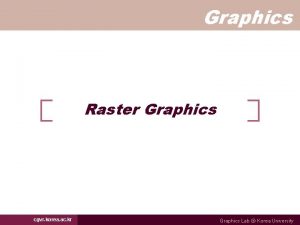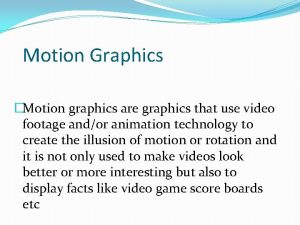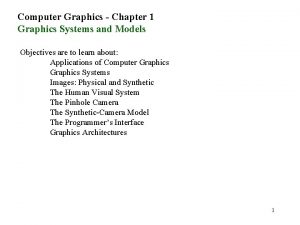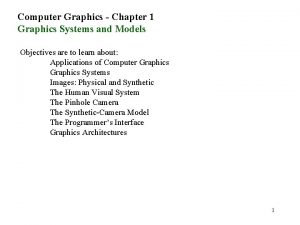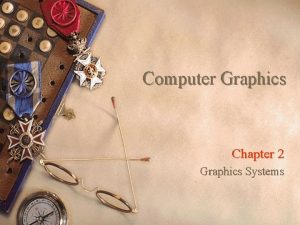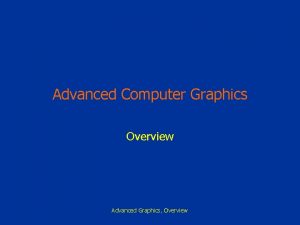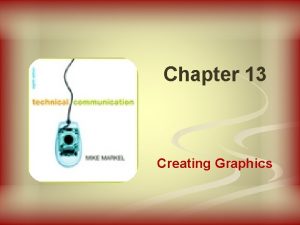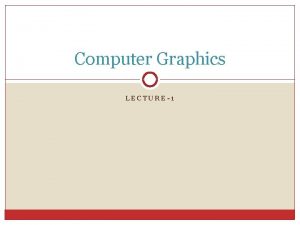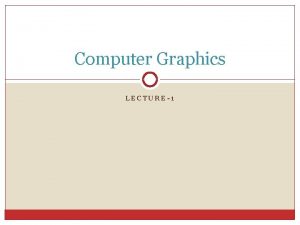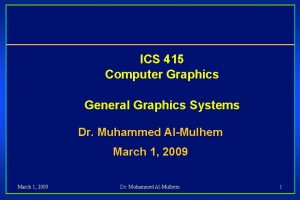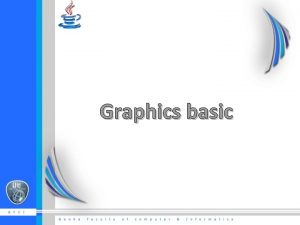OVERVIEW OF GRAPHICS SYSTEMS n Chapter 2 Overview
























































- Slides: 56

OVERVIEW OF GRAPHICS SYSTEMS n. Chapter- 2

Overview of Computer Graphics output technology may be split into two categories: Non-permanent output to a screen Permanent output to a paper Recently all devices are digital in nature: Therefore, producing images become the process of setting individual points on the screen or on paper The points are laid out in a regular pattern on the output media. 2

Video Display Devices Refresh Cathode-Ray Tubes (CRTs) Ø Raster-Scan Displays Ø Random-Scan Displays Ø Color CRT Monitors Ø Flat-Panel Displays Ø

Refresh Cathode-Ray Tubes (CRT) A beam of electrons emitted by an electron gun, passes through focusing and deflection systems that direct the beam toward specified positions on the phosphor-coated screen. Because the light emitted by the phosphor fades very rabidly, the refresh process is needed to maintain the picture on the screen. 4

Refresh Cathode-Ray Tubes (CRT) 5

Heating filament cathode Accelerating Anode

Refresh CRTs - continued Refreshing is done by redrawing the picture repeatedly by quickly directing the electron beam back over the same screen points. Refresh rate: the frequency at which a picture is redrawn on the screen. 7

Components of the Electron Gun : 1. The heated metal cathode 2. A control grid Heat is supplied to the cathode by directing a current through a coil of wire (the filament) inside the cathode. This causes electrons to be “boiled off” the hot cathode surface. Then, the free, negatively electrons are then accelerated towards the phosphor coating by a high positive voltage. 8

9 Overview of Graphics Systems

10

Intensity of the electron beam is controlled by the voltage at the control grid. A high negative voltage applied to the control grid will shut off the beam. A smaller negative voltage on the control grid decreases the number of electrons passing through. The brightness of a display point is controlled by varying the voltage on the control grid. 11

The focusing system forces the electron beam to converge to a small cross section as it strikes the phosphor. Deflection of the electron beam can be controlled by the deflection coils. Spots of light are produced on the screen by the transfer of the CRT beam energy to the phosphor. Persistence: how long phosphors continue to emit light after the CRT beam is removed. Persistence is defined as the time that it takes the emitted light from the screen to decay to one-tenth of its original intensity. Lower-persistence phosphors require high refresh rates to maintain a picture definition on the screen without flicker and they are useful for animation. Higher-persistence phosphors are useful for displaying highly complex, static pictures. 12

Few important points Any given phosphor has several different quantom- levels to which electors can be excited, each corresponding to a color associated with the return to an unexcited state. Phosphorescence is the light given off by the return of the relatively more stable excited electrons to their unexcited state once the electron beam excitation is removed. It is typically 10 -60 microsecond. As refresh rate decreases , flicker develops because eye can no longer integrate the individual light impulses coming from pixel. The refresh rate above which a picture stops flickering and fuses into a steady image is called the critical fusion frequency. 13

A flicker free picture appears constant or steady to the viewer. The longer the persistence, the lower the CFF. To see the continuously refreshed image without flicker the refresh rate has to be at least 60 c/s. To allow continuous refreshing of an image there must be some stored representation of the image from which the refresh system can obtain the graphical information required to redraw the image. 14

=> A set of values of intensity/color at each of a discrete set of points laid out in a rectangular array covering the screen. Advantages: It is possible to edit an image by changing the stored representation between refresh cycles for what appears to be instantaneous updating of the image. Animation 15

Resolution: the maximum number of points that can be displayed without overlap on the CRT. Resolution of the CRT is dependent on the type of phosphor, the intensity to be displayed, and the focusing and deflection systems. Typical resolution on high-definition systems is 1280 by 1024 16

Raster-Scan Displays The electron beam is swept across the screen one row at a time from top to bottom. Each row is referred to as a scan line. Picture definition is stored in the frame buffer. This memory area holds the set of intensity values for the screen points. These stored values are then retrieved from the refresh buffer and used to control the intensity of the electron beam as it moves from spot to spot across the screen. 17

Refreshing on raster-scan display is carried out at the rate of 60 -80 frames per seconds, this can be done by using following retrace techniques Horizontal retrace Vertical retrace 18

19

The scan is synchronized with the access of the intensity values held in the frame buffer. The maximum resolution is determined by: The characteristics of the monitor Memory capacity available for storing the frame buffer 20

Aspect ratio: the number of horizontal points to vertical points necessary to produce equal-length lines in both directions on the screen. An aspect ratio of 4/3 means that a horizontal line plotted with four points has the same length as a vertical line plotted with three points. The range of colors that can be displayed on a raster system depends on both the types of phosphor used in the CRT and the number of bits per pixel available in the frame buffer. 21

For example, a system with 24 bits per pixel and a screen resolution of 1024 by 1024 requires 3 megabytes of storage for the refresh buffer. A bitmap image: a frame buffer with one bit per pixel. a pixmap image: a frame buffer with multiple bits per pixel. Typically refresh rates are 60 to 80 frames per second 22

Horizontal retrace: the return of the electron beam to the left of the screen after refreshing each scan line. Vertical retrace: the return of the electron beam to the top left corner of the screen to begin he next frame. On some raster-scan systems and TV sets, each frame is displayed in two passes using an interlaced refresh procedure. 23

In the first pass, the beam sweeps across every other scan line (even-numbered) from top to bottom. After the vertical retrace, the beam then sweeps out the remaining scan lines (odd numbered). Advantages of interlacing: Ø The screen is displayed in one-half the time taken by the other method. Ø Used with slower refresh rates to avoid flicker. An effective technique provided that adjacent scan lines contain similar display information. More about scan conversion: The conversion of continuous quantities to discrete quantities can cause aliasing errors such as stair case effect. 24

Random-Scan Displays The electron beam directed only to those parts of the screen where a picture is to be displayed. Sometimes called: store-writing or calligraphic displays. Picture definition is stored as a set of line-drawing commands. Draws all the component lines of a picture 30 to 60 times each second, with up to 100, 000 “short” lines in the display list. 25

Designed for line-drawing applications and they cannot display realistic shaded scenes. A pen plotter operate in a similar way. Draws the components lines of an object in any order specified. Have higher resolution than raster-scan systems. Produce smooth line drawing. 26

Refresh rate on a random scan system depends on the number of lines to be displayed. Picture definition is now stored as a set of line-drawing commands in an area of memory referred to as the refresh display file. Other names: display list, display program or refresh rate “A set of commands”. After all line drawing commands have been processed, the system cycles through the set of commands in the display file. All component lines of a picture are drawn 30 to 60 times each second When a small set of lines is to be displayed each refresh cycle is delayed to avoid refresh rates greater than 60 27 frames per second.

28 Overview of Graphics Systems

Advantages: For line drawing applications Higher resolution than raster scan systems Smooth lines Disadvantages: Cannot display realistic shaded scenes Faster refreshing of the set of lines could burn out the phosphor 29

Adv & Dis of Raster Graphics Advantages: Inexpensive: Many facilities, e. g. filled areas, pattern, colors, shaded images … etc. can be used to produce realistic images Because it is a refresh type system, it may be used for image amendment and animation by changing the contents of the frame buffer between refresh cycles The refresh process is independent of the image complexity Disadvantages: Every graphical output primitive has to be scan converted before display Aliasing errors, e. g. stair case effect Increasing resolution is expensive => more memory 30

Color CRT Monitors Cathode Ray Tube(CRT) is the most common display device High resolution Good color fidelity High contrast (400: 1) High update rates Techniques for producing color : Beam penetration method Shadow mask method

Beam Penetration Method Random scan monitors use the beam penetration method for displaying color picture. In this, the inside of CRT screen is coated two layers of phor namely red and green. A beam of slow electrons excites ony the outer red layer, while a beam of fast electrons penetrates red layer and excites the inner green layer. At intermediate beam speeds, combination of red and green light are emitted to show two addtional colorsorange and yellow.


Advantages Less expensive Disadvantages Quality of images are not good as comparatable with other methods Four colors are allowed only

Shadow Mask Method Raster scan system are use shadow mask methods to produced a much more range of colors than beam penetration method. In this, CRT has three phosphor color dots. One phosphor dot emits a red light, second emits a green light and third emits a blue light.

This type of CRT has three electrons guns and a shadow mask grid as shown in figure below:

In this figure, three electrons beams are deflected and focused as a group onto the shadow mask which contains a series of holes. When three beams pass through a hole in shadow mask they activate dot triangle as shown in figure below:

Advantages produce realistic images also produced different colors and shadows scenes. Disadvantages low resolution expensive electron beam directed to whole screen

Direct View Storage Tube(DVST) A cathode-ray tube in which secondary emission of electrons from a storage grid is used to provide an intensely bright display for long and controllable periods of time. Also known as display storage tube; viewing storage tube. These monitors can play high resolution picture without flicker.

Flat Panel Displays Thin screen displays found with all portable computers and becoming the new standard with desktop computers. Instead of utilizing the cathode-ray tube technology flat-panel displays use Liquid-crystal display (LCD) technology or other alternative making them much lighter and thinner when compared with a traditional monitor.

3 D Viewing Devices A 3 D display is any display device capable of conveying a stereoscopic perception of 3 -D depth to the viewer.

As the varifocal mirror vibrates, it changes focal length. These vibrations are synchronized with the display of an object on a CRT so that each point on the object is reflected from the mirror into a spatial position corresponding to the distance of that point from a specified viewing position. This allows us to walk around an object or scene and view it from different sides.

Raster Scan Systems Interactive raster-graphics systems typically employ several processing units. In addition to the CPU, a special purpose processor called the video controller or display controller is used to control the operation of the display device. Here the frame buffer is in the system memory, the video controller access the frame buffer to refresh the screen.

1. Video Controller A fixed area of the system memory is reserved for the frame buffer, and the video controller is given direct access to the frame buffer memory. The co-ordinates of the graphics monitor starts at the lower left screen corner. Positive x values increasing to the right and y values increasing from bottom to top.




2. Display Processor The purpose of the display processor or graphics controller is to free the CPU from the graphics chores. In addition to the system memory a separate display processor memory area can also provided. A major task of the display processor is digitizing a picture definition given in an application program into a set of pixel-intensity values for storage in the frame buffer. This digitization process is called scan conversion. Lines and other geometric objects are converted into set of discrete intensity points. Characters can be defined with rectangular grids, or they can be defined with curved outlines.

To reduce the memory space required to store the image information, each scan line are stored as a set of integer pairs. One number of each pair indicates an intensity value, and the second number specifies number of adjacent pixels the scan line that is also having same intensity. This technique is called run-length encoding.

The above diagram shows the refresh operation of video controller. Two registers are used to store the co-ordinates of the screen pixels. Initially x=0 and y=ymax

The value stored in the frame buffer corresponding to this pixel position is retrieved. And the x value is incremented by 1 and the corresponding y value is retrieved, like that the pixel values are retrieved line by line. Once the last pixel is reached again the registers are reset to initial value to repeat the process.


Random Scan Systems An application program is input and stored in the system memory along with a graphics package. Graphics commands in the program are translated by the graphics package into a display file stored in the system memory. This display file is then accessed by the display processor to refresh the screen. The display processor cycles through each command in the display file program once during every refresh cycle.


Graphic patterns are drawn on a random scan system by directing the electron beam along the component lines of the picture. Lines are defined by the values for their co- ordinate endpoints, and these input co-ordinate values are converted to x and y deflection voltages. A scene is then drawn one line at a time by positioning the beam to fill in the line between specified endpoints.

Basic input devices include the Keyboard Mouse Digitizer Trackball Touch Screens Light Pens Microphones Bar code readers Joysticks Scanners Voice Systems
 Graphics monitors and workstations and input devices
Graphics monitors and workstations and input devices Dot matrix display ppt
Dot matrix display ppt Goal directed systems in computer graphics
Goal directed systems in computer graphics Distributed systems
Distributed systems Crtd in sap
Crtd in sap Distributed systems overview
Distributed systems overview I/o device management in operating system
I/o device management in operating system Operating system overview
Operating system overview Decision support systems and intelligent systems
Decision support systems and intelligent systems Dicapine
Dicapine Embedded systems vs cyber physical systems
Embedded systems vs cyber physical systems Elegant systems
Elegant systems Polygon clipping in computer graphics ppt
Polygon clipping in computer graphics ppt Chapter 8 graphics
Chapter 8 graphics Line drawing algorithm in computer graphics ppt
Line drawing algorithm in computer graphics ppt Chapter 3 graphics
Chapter 3 graphics Emt chapter 24 trauma overview
Emt chapter 24 trauma overview Emt chapter 14 medical overview
Emt chapter 14 medical overview Chapter 9 lesson 2 photosynthesis an overview
Chapter 9 lesson 2 photosynthesis an overview Chapter 12 selling overview
Chapter 12 selling overview Chapter 2 an overview of the financial system
Chapter 2 an overview of the financial system Chapter 1 overview of verb tenses
Chapter 1 overview of verb tenses Overview of personal finance chapter 1
Overview of personal finance chapter 1 Mesioclusion
Mesioclusion Introduction to personal finance answers
Introduction to personal finance answers General features of animals
General features of animals Chapter 1 an overview of financial management
Chapter 1 an overview of financial management Elements and their properties section 1 metals
Elements and their properties section 1 metals Chapter 1 overview of financial statement analysis
Chapter 1 overview of financial statement analysis Chapter 28 human systems and homeostasis
Chapter 28 human systems and homeostasis Signals and systems oppenheim solutions chapter 5
Signals and systems oppenheim solutions chapter 5 Chapter 15 river systems answers
Chapter 15 river systems answers Management information system chapter 1
Management information system chapter 1 Chapter 11 lubrication systems answer key
Chapter 11 lubrication systems answer key Chapter 3 lesson 1 introduction to global systems
Chapter 3 lesson 1 introduction to global systems Chapter 10 ignition systems
Chapter 10 ignition systems Lower court
Lower court Chapter 2 economic systems and decision making
Chapter 2 economic systems and decision making Questions on digestive system
Questions on digestive system Chapter 30 engine starting systems
Chapter 30 engine starting systems Securing information systems
Securing information systems Chapter 8 securing information systems
Chapter 8 securing information systems Chapter 7 accounting information systems
Chapter 7 accounting information systems Chapter 7 accounting information systems
Chapter 7 accounting information systems Types of matrix bands in dentistry
Types of matrix bands in dentistry Section 39-4 fertilization and development
Section 39-4 fertilization and development Chapter 36 skeletal muscular and integumentary systems
Chapter 36 skeletal muscular and integumentary systems Ovulation animation
Ovulation animation Chapter 33 section 1 the circulatory system
Chapter 33 section 1 the circulatory system Chapter 2 economic systems answer key
Chapter 2 economic systems answer key Chapter 2 economic systems and decision making
Chapter 2 economic systems and decision making Chapter 15 water and aqueous systems worksheet answers
Chapter 15 water and aqueous systems worksheet answers Water and aqueous systems chapter 15 answers
Water and aqueous systems chapter 15 answers On a wet barrel hydrant where is the valve located
On a wet barrel hydrant where is the valve located Chapter 14 lesson 3 the nervous system
Chapter 14 lesson 3 the nervous system Dfd ch 13
Dfd ch 13 Chapter 10 ignition systems
Chapter 10 ignition systems


